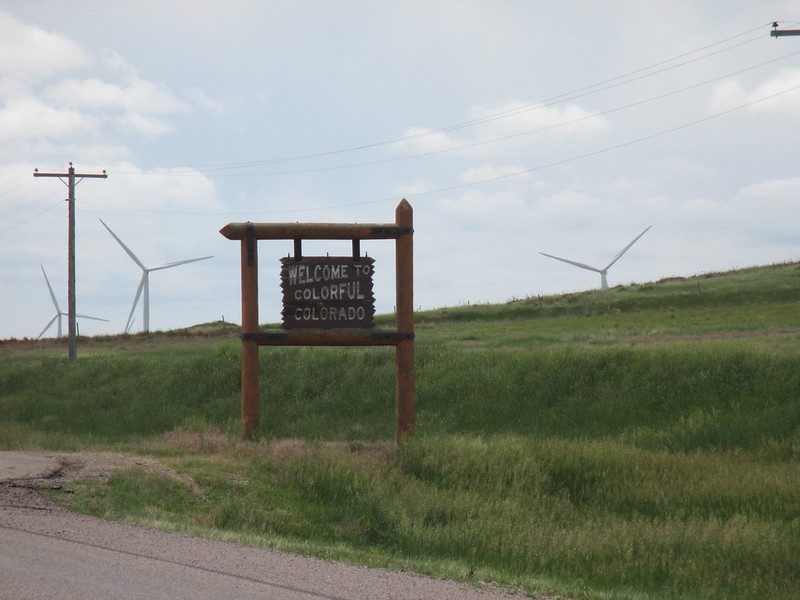
Photo by Flickr user Tom Benson, CC BY-NC-ND 2.0
In November 2000, Colorado voters faced a ballot initiative known as Amendment 24, which would have required many communities in the state to adopt comprehensive plans with urban growth boundaries. The amendment sought to manage development and habitat destruction by requiring local governments to plan ahead, delineating areas for future development. The measure generated some predictable opponents, including many for-profit developers who viewed it as a threat to their ability to build what they wanted, where they wanted.
But the amendment had some less predictable opposition as well. Affordable housing advocates feared the proposal would cause housing costs to rise and lead to an increase in NIMBYism, the all-too-common demand that housing for the less-than-affluent be built somewhere else, “not in my backyard.” With that in mind, Habitat for Humanity and the Colorado Affordable Housing Partnership joined development interests in opposing the measure, which was defeated.
Conflicts like this one suggest that smart growth and affordable housing advocates are necessarily on opposing sides of an “either/or” debate – either plan future growth consciously or create more affordable housing. It’s a false choice, though. At their core, smart growth and affordable housing are not only compatible, but complementary, and the two movements are starting to find shared policy agendas and ways to work together.
Smart growth is a set of principles and strategies for development that emphasizes walkable, livable communities through improved regional planning, more compact development, planned growth patterns, a mix of land uses, and greater choice in transportation and housing – including affordable housing. It is a response to the problems that communities have been suffering as a result of current development patterns: loss of open space, long commutes, growing traffic congestion, and concentrations of poverty. It is not “no-growth”; done well, it makes regional needs, such as economic development and affordable housing, fundamental pieces of the community’s own vision of how and where it wants to grow.
It’s an appealing vision, but many within the affordable housing community worry that the measures taken to achieve it may exacerbate the existing housing crisis. They argue, for example, that growth boundaries – one of many tools that can be used to achieve smart growth – shrink the supply of available land, forcing up costs – and therefore housing prices. It is an argument the many opponents of Portland, Oregon’s urban growth boundary have been trying to make for years.
Opponents have also misused the term “smart growth” and applied it to more restrictive proposals – such as flat-out building moratoria or zoning changes that restrict growth in some areas without accommodating it in others – and used them to press their case that smart growth is bad for housing. Other opponents of smart growth assert that the status quo is advantageous for affordability. Those who oppose any restrictions on development have used housers’ fears to their advantage. Developers in Colorado spent an unprecedented $6 million on a campaign not only to highlight the shortfalls of Amendment 24, but to portray it as a choice between managing growth and affordable housing.
But the facts do not bear out the charges against smart growth. Over the last 10 years, house prices in Colorado have risen at least as fast in areas with no growth management as in areas with it. Opponents point to a smart-growth city like Portland, Oregon, where housing prices have risen rapidly, but most of the increase there can be attributed to the city’s economic boom. House prices in Salt Lake City, for example, which has no growth boundary, increased at a similar rate to Portland’s throughout the 1990s. Preliminary indications from research forthcoming from the Brookings Institution and Smart Growth America suggest that growth containment policies that actively consider housing needs do not contribute to an affordability crisis.
Meanwhile, conventional development patterns actually harm housing affordability in many ways. Zoning regulations mandating minimum building and lot sizes make it difficult for builders to construct smaller “starter” homes for more affordable homeownership, even where market demand exists for such homes. Many communities also zone out or discourage multi-family housing, motivated either by NIMBY concerns or a perception that they cost more to service than they pay in property taxes. And the growing dispersion of housing over large areas has made transportation costs grow to an all-time high – now 18 cents of every dollar spent by the average household – as people need more private vehicles to reach jobs and services.
Smart growth offers solutions to many of these problems. In the eyes of a growing number of community builders, it is an unprecedented opportunity to address the many areas of interest that housing and smart-growth advocates share: reinvesting in existing cities, creating mixed-income communities, and providing housing near jobs. When proposals and plans actively consider both goals, the results can be better for both constituencies.
Smart growth encourages investment in existing neighborhoods, providing better services and improved access to jobs and other resources for residents. This also creates opportunities to reestablish communities that have a lot of neighbor interaction and renewed social capital. This is clearly part of a community developer’s agenda as well, provided enough care is taken to maintain housing affordability and minimize displacement.
By insisting on examining housing and other development needs at a regional level, smart growth also reduces the opportunity for some communities to zone only for high-income housing, leaving others to bear more than their fair share of housing for the poor. Regional planning can mean a better distribution of affordable housing and fewer pockets of poverty and disinvestment.
Smart growth connects the development of affordable housing to jobs, services, commerce, transportation, and recreation. When affordable housing is connected more closely to other land uses and is available in all centers of a region, rather than concentrated in a few cities, isolation, long commutes, and transportation costs can be reduced.
Smart growth also expands the range of choice available to American households, both in housing type and location, by encouraging a comprehensive, regional review of zoning and other planning tools, looking for ways to make them more flexible so that rehab, infill, multi-family housing, and mixed-use neighborhoods all become more feasible. By changing the framework within which development occurs, we allow the private sector to provide housing solutions that are currently unavailable or difficult to produce.
To make all of these possibilities into realities, the housing and smart-growth movements must learn to work together. This is not the standard modus operandi yet. For example, 1000 Friends of Florida is the only one of a network of smart growth– focused 1000 Friends groups to have a program dedicated to housing issues. But even after 10 years on the job, Affordable Housing Director Jaimie Ross still has to explain to some environmentalists why housing is important. “By and large, environmentalists do not embrace affordable housing as a community asset,” she says. “There is a still a learning curve.”
There is hope, though. Smart growth advocates increasingly recognize the value of working with housing advocates and overcoming their lack of awareness about housing issues. Ross helps to bridge the gap by emphasizing specific issues that housing advocates and smart growth advocates have in common, such as comprehensive planning. She reports that local housers have really embraced the need for smart growth.
Currently, 1000 Friends of Florida is working directly with five local governments to enact inclusionary zoning ordinances and plans to provide technical support to community land trusts. Both of these approaches will increase the supply and permanence of affordable housing units; they also help to achieve smart-growth goals, expanding the range of housing choices available to people and strengthening communities. Ross’s approach – focusing on proposals and policies that serve the goals of both movements – can be a model for other groups on that learning curve.
There is a plethora of policies out there that can form the basis for an initial working relationship. Rehab subcodes, pioneered in New Jersey, allow owners of older housing stock to upgrade their properties without having to meet standards designed for new construction. (See Shelterforce #109.) By reducing the cost of rehab, the subcodes encourage reuse of existing structures and reinvestment in already developed areas, reducing outward pressure.
Changing zoning codes to allow accessory dwelling units is another promising avenue. So-called “granny flats” or “in-law apartments” are an ideal way to create new affordable housing for single or elderly people and increase density in existing single-family neighborhoods without significantly changing their character. Fast-growing Cary, North Carolina, plans to eliminate restrictions that currently require accessory units to be attached to the main building and occupied by relatives. The change is being made through a new zoning ordinance and is a key part of the city’s affordable housing plan.
Connections like these are finally being made on a national level too. The National Low Income Housing Coalition’s 2001 “NIMBY Report” focused exclusively on the challenges and opportunities associated with sprawl and smart growth. The Smart Growth Network recently released the report Affordable Housing and Smart Growth: Making the Connection. And the National Neighborhood Coalition, LISC, and the Federal Reserve Bank of Richmond called the first conference on smart growth and community development. Advocates on both sides may well look back on 2001 as a turning point.
Even in Colorado, where the national spotlight illuminated the gap between smart growth and affordable housing camps, bridges are being built. “People are increasingly willing to take a real look at the problem and make the difficult decisions,” says Ann Livingston of Colorado’s Public Interest Research Group (COPIRG), an environmental advocacy group. COPIRG and the Colorado Affordable Housing Partnership, which found themselves on opposite sides of the Amendment 24 debate, came together, along with a range of other organizations, to draft legislation that would help Colorado both manage growth and improve affordability.
The plan proposed mandatory comprehensive plans, urban service areas, and requirements that communities demonstrate how they will achieve a balance of jobs and housing, and it more clearly articulated the housing element of regional planning efforts. Despite early setbacks in efforts to pass the legislation in special session in late 2001, there is an “emerging awareness that [smart growth and affordable housing groups] are natural allies,” says Mary Boland of Catholic Charities of Denver, a group that advocates for affordable housing.
Colorado’s challenge echoes that facing many of the 39,000 communities across the U.S. Fortunately, innovative approaches pioneered at the local level, and expanding partnerships at the local and national levels, can help guide communities as they navigate this difficult path.
Affordable Housing and Smart Growth: Making the Connection details a host of policies that can benefit both movements. See it here.




Comments